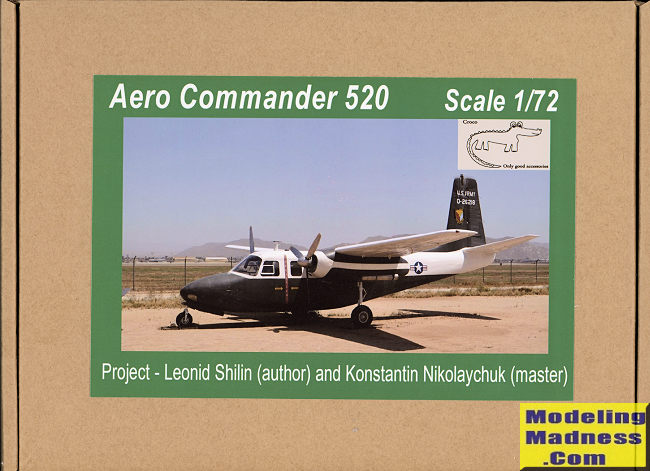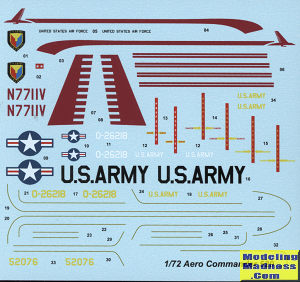
Croco 1/72 Aero Commander 520
| KIT #: | |
| PRICE: | $ |
| DECALS: | Three options |
| REVIEWER: | Scott Van Aken |
| NOTES: | Short run resin kit with vacuform clear parts. |

| HISTORY |
The Aero Commander 500 family is a series of light-twin piston-engined and turboprop aircraft originally built by the Aero Design and Engineering Company in the late 1940s, renamed the Aero Commander company in 1950, and a division of Rockwell International from 1965. The initial production version was the 200-mph, seven-seat Aero Commander 520. An improved version, the 500S, manufactured after 1967, is known as the Shrike Commander. Larger variants are known by numerous model names and designations, ranging up to the 330-mph, 11-seat Model 695B/Jetprop 1000B turboprop.
In military service, it was initially designated the L-26, though in 1962 this was changed to U-4 for the United States Air Force and U-9 for the United States Army.Under ownership of Rockwell in the 1960s, World War II pilot R. A. "Bob" Hoover demonstrated the Shrike Commander 500S for decades in a variety of "managed energy" routines, including single-engine and engine-out aerobatics. His Shrike Commander is displayed in the colors of his last sponsor, Evergreen International Aviation, at the Steven F. Udvar-Hazy Center of the Smithsonian Air and Space Museum. Bob Odegaardcontinued the tradition in 2012, flying a 1975 Shrike 500S in a Bob Hoover tribute routine.
One U-4B became a presidential transport aircraft for Dwight D. Eisenhower between 1956 and 1960. This was the smallest "Air Force One," and the first to wear the now-familiar blue-and-white livery.
| THE KIT |
 Croco
is based in Latvia and has embarked on a program of providing resin kits of some
lesser known military and civil aircraft. This particular kit is an Aero
Commander 520, the first production model and one that was used quite a bit by
the US Army and some by the USAF.
Croco
is based in Latvia and has embarked on a program of providing resin kits of some
lesser known military and civil aircraft. This particular kit is an Aero
Commander 520, the first production model and one that was used quite a bit by
the US Army and some by the USAF.
The kit is nicely molded with fine engraved panel
lines. Typical of the genre, you will need to clean up every part as there is
some flash on it all. I found a few air pockets, but they were quite small and
those of us who have built kits like this should be used to finding things like
this. Rather than show a mass of small resin parts embedded in resin wafers, I
thought I'd provide some of the major bits and a couple of the bags of smaller
parts.
You are provided with a full cockpit and cabin with the latter having standard
'airline' seats. The cockpit has the usual seats control columns and instrument
panel. All of the clear bits are vacuform plastic and two full sets are
provided for the cockpit section and the cabin windows. You also get clear nose
landing lights which go on either side of the nose.
All the flight surfaces are a single casting. This is a high wing aircraft and I
would seriously recommend some sort of additional metal pins to help hold it in
place. The plane is powered by two flat six engines which are included so you'll
have something to see through the forward engine cowlings. You are provided with
two different forward cowling styles. The prop blades and hubs are separate
pieces so this will benefit from a simple jig to keep the blades at the proper
angles.
The main landing gear is surprisingly complex so care will need to be taken in assembly of this structure, but they should prove to be quite strong when done. Landing gear doors are also nicely done and I would bet that you'd be able to model this one with the gear up though you'll need to supply your own stand.
 Instructions
are hand drawn and very nicely done. All the parts are numbered in the
instructions and there are detail drawings to show how some of the more complex
bits fit. Finding places for nose weight may well be a challenge so be prepared
to make a tail stand. Markings are very nicely printed and offer one of three
Army planes in Olive Drab and White as shown on the box art and one civilian
plane. All the markings options have photos to go with them. Pretty sure these
images were gleaned from the Internet so you may wish to do a bit of a search to
get larger images as there are differences in the colors of the serials and the
prop warning markings. The sheet also includes small US Air Force logos. The
USAF planes would be Insignia blue and white.
Instructions
are hand drawn and very nicely done. All the parts are numbered in the
instructions and there are detail drawings to show how some of the more complex
bits fit. Finding places for nose weight may well be a challenge so be prepared
to make a tail stand. Markings are very nicely printed and offer one of three
Army planes in Olive Drab and White as shown on the box art and one civilian
plane. All the markings options have photos to go with them. Pretty sure these
images were gleaned from the Internet so you may wish to do a bit of a search to
get larger images as there are differences in the colors of the serials and the
prop warning markings. The sheet also includes small US Air Force logos. The
USAF planes would be Insignia blue and white.
| CONCLUSIONS |
Kits like this are certainly most welcome and fill gaps that we are likely not going to see from the injection molded crowd. This one is very much for experienced modelers, thanks to the medium and some fairly small pieces. However, the results should be superb and well worth the effort it will take to build.
| REFERENCES |
https://en.wikipedia.org/wiki/Aero_Commander_500_family
March 2019 Copyright ModelingMadness.com.
All rights reserved.
Thanks to Croco for the preview item. Contact them at sniff23@inbox.lv for information and costs. You can also find these on ebay.
If you would like your product reviewed fairly and fairly quickly, please contact the editor or see other details in the Note to Contributors.